Risk and Risk Management Concepts Report - Environmental Engineering
VerifiedAdded on 2021/06/14
|105
|27941
|54
Report
AI Summary
This comprehensive report delves into the multifaceted realm of risk and risk management, with a specific focus on the oil and gas industry. It begins with a literature review, exploring key concepts and definitions of risk, vulnerability, and their interplay within the sector. The report examines various hazard scenarios, including vapor cloud explosions, pool fires, and toxic dispersions, and analyzes failure frequencies using generic data and the LOPA methodology. It investigates risk modeling, terminology, and the process of rating risks, while also considering qualitative and quantitative aspects. The report emphasizes the importance of process safety indicators and the application of risk management strategies to prevent accidents and ensure operational safety. The methodology section outlines the research philosophy, strategy, and the use of mixed research methodologies, including surveys, questionnaires, interviews, and case studies, to gather and analyze data. The report underscores the significance of cyber security vulnerabilities, digital technologies, and the need for robust risk management frameworks to mitigate potential threats and ensure the industry's resilience.
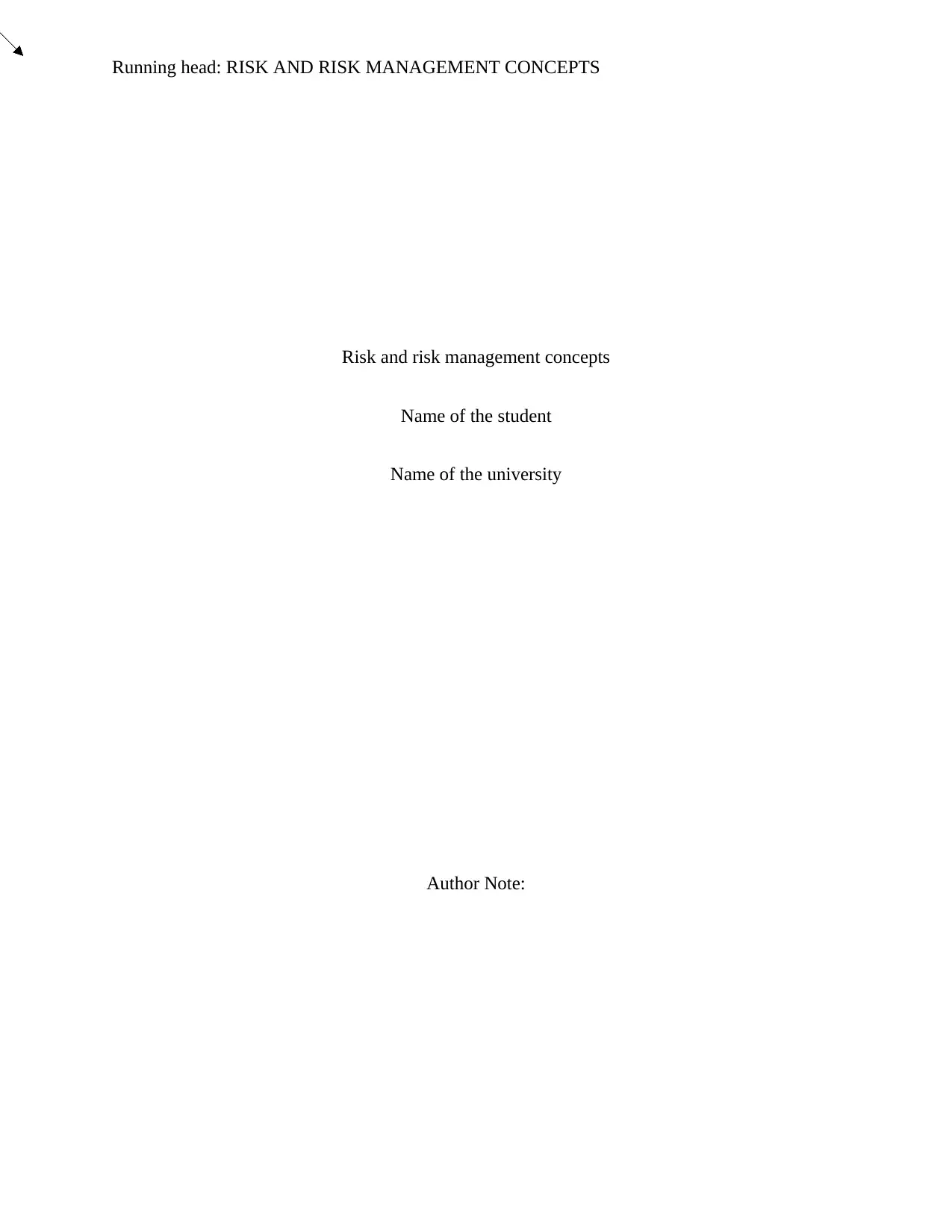
Running head: RISK AND RISK MANAGEMENT CONCEPTS
Risk and risk management concepts
Name of the student
Name of the university
Author Note:
Risk and risk management concepts
Name of the student
Name of the university
Author Note:
Paraphrase This Document
Need a fresh take? Get an instant paraphrase of this document with our AI Paraphraser
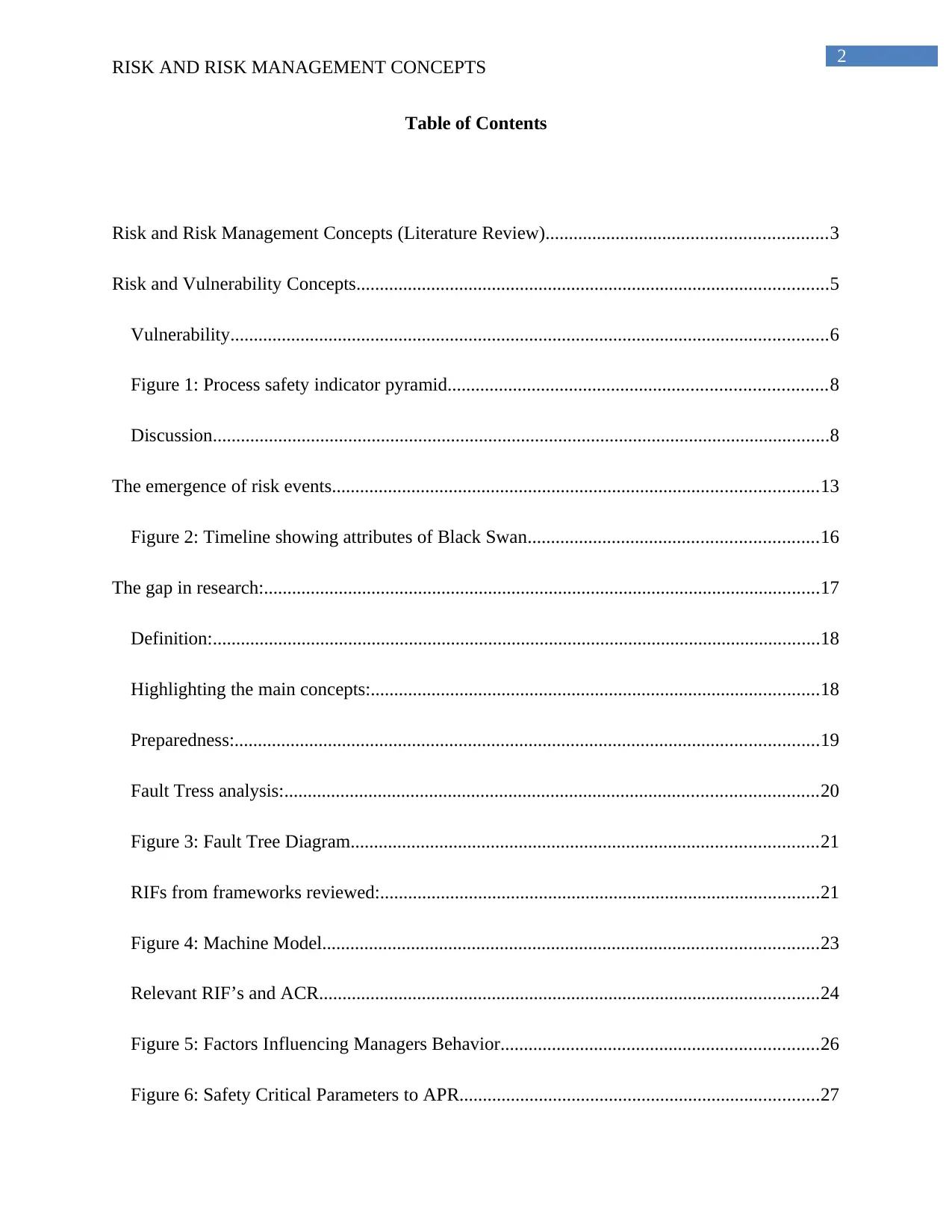
2
RISK AND RISK MANAGEMENT CONCEPTS
Table of Contents
Risk and Risk Management Concepts (Literature Review)............................................................3
Risk and Vulnerability Concepts.....................................................................................................5
Vulnerability................................................................................................................................6
Figure 1: Process safety indicator pyramid.................................................................................8
Discussion....................................................................................................................................8
The emergence of risk events........................................................................................................13
Figure 2: Timeline showing attributes of Black Swan..............................................................16
The gap in research:.......................................................................................................................17
Definition:..................................................................................................................................18
Highlighting the main concepts:................................................................................................18
Preparedness:.............................................................................................................................19
Fault Tress analysis:..................................................................................................................20
Figure 3: Fault Tree Diagram....................................................................................................21
RIFs from frameworks reviewed:..............................................................................................21
Figure 4: Machine Model..........................................................................................................23
Relevant RIF’s and ACR...........................................................................................................24
Figure 5: Factors Influencing Managers Behavior....................................................................26
Figure 6: Safety Critical Parameters to APR.............................................................................27
RISK AND RISK MANAGEMENT CONCEPTS
Table of Contents
Risk and Risk Management Concepts (Literature Review)............................................................3
Risk and Vulnerability Concepts.....................................................................................................5
Vulnerability................................................................................................................................6
Figure 1: Process safety indicator pyramid.................................................................................8
Discussion....................................................................................................................................8
The emergence of risk events........................................................................................................13
Figure 2: Timeline showing attributes of Black Swan..............................................................16
The gap in research:.......................................................................................................................17
Definition:..................................................................................................................................18
Highlighting the main concepts:................................................................................................18
Preparedness:.............................................................................................................................19
Fault Tress analysis:..................................................................................................................20
Figure 3: Fault Tree Diagram....................................................................................................21
RIFs from frameworks reviewed:..............................................................................................21
Figure 4: Machine Model..........................................................................................................23
Relevant RIF’s and ACR...........................................................................................................24
Figure 5: Factors Influencing Managers Behavior....................................................................26
Figure 6: Safety Critical Parameters to APR.............................................................................27
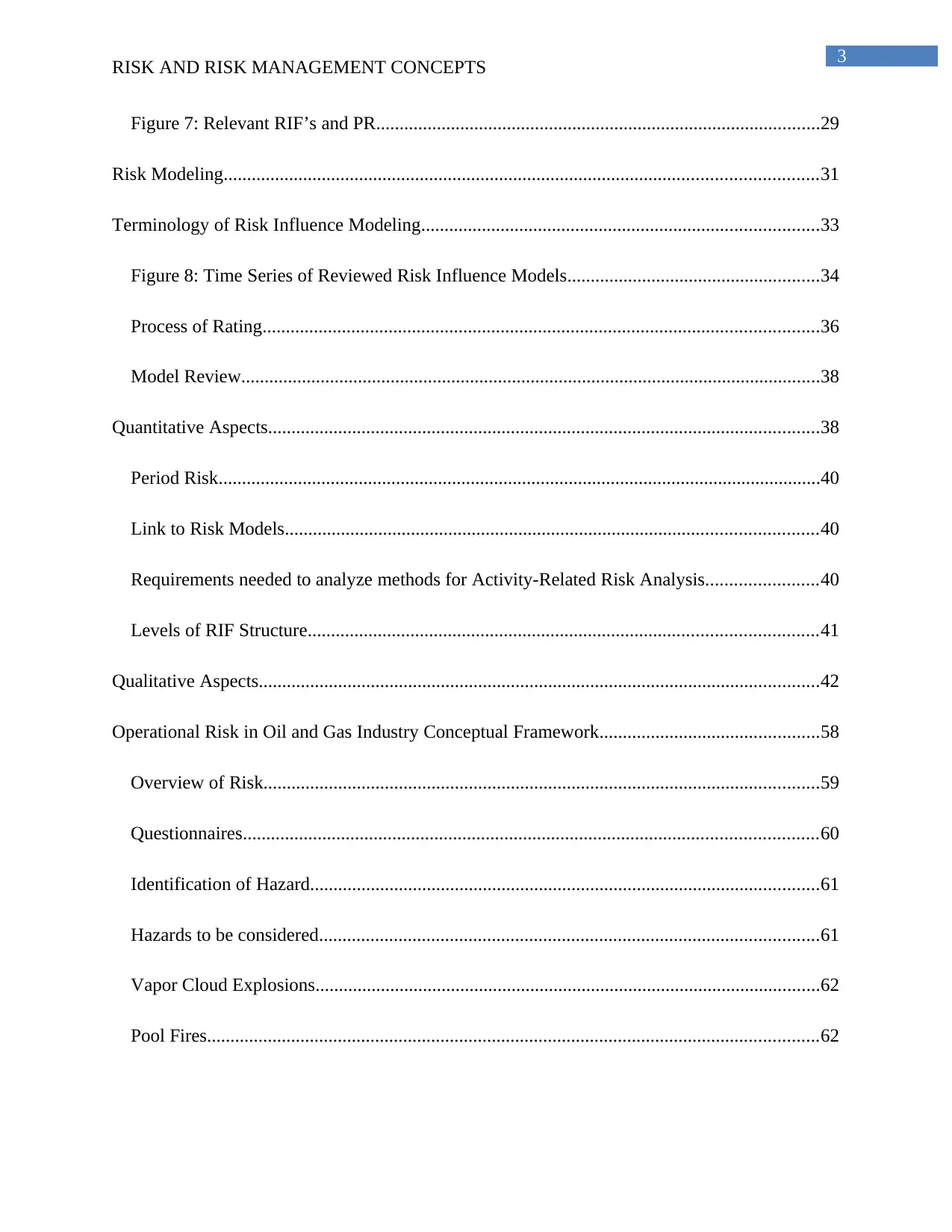
3
RISK AND RISK MANAGEMENT CONCEPTS
Figure 7: Relevant RIF’s and PR...............................................................................................29
Risk Modeling...............................................................................................................................31
Terminology of Risk Influence Modeling.....................................................................................33
Figure 8: Time Series of Reviewed Risk Influence Models......................................................34
Process of Rating.......................................................................................................................36
Model Review............................................................................................................................38
Quantitative Aspects......................................................................................................................38
Period Risk.................................................................................................................................40
Link to Risk Models..................................................................................................................40
Requirements needed to analyze methods for Activity-Related Risk Analysis........................40
Levels of RIF Structure.............................................................................................................41
Qualitative Aspects........................................................................................................................42
Operational Risk in Oil and Gas Industry Conceptual Framework...............................................58
Overview of Risk.......................................................................................................................59
Questionnaires...........................................................................................................................60
Identification of Hazard.............................................................................................................61
Hazards to be considered...........................................................................................................61
Vapor Cloud Explosions............................................................................................................62
Pool Fires...................................................................................................................................62
RISK AND RISK MANAGEMENT CONCEPTS
Figure 7: Relevant RIF’s and PR...............................................................................................29
Risk Modeling...............................................................................................................................31
Terminology of Risk Influence Modeling.....................................................................................33
Figure 8: Time Series of Reviewed Risk Influence Models......................................................34
Process of Rating.......................................................................................................................36
Model Review............................................................................................................................38
Quantitative Aspects......................................................................................................................38
Period Risk.................................................................................................................................40
Link to Risk Models..................................................................................................................40
Requirements needed to analyze methods for Activity-Related Risk Analysis........................40
Levels of RIF Structure.............................................................................................................41
Qualitative Aspects........................................................................................................................42
Operational Risk in Oil and Gas Industry Conceptual Framework...............................................58
Overview of Risk.......................................................................................................................59
Questionnaires...........................................................................................................................60
Identification of Hazard.............................................................................................................61
Hazards to be considered...........................................................................................................61
Vapor Cloud Explosions............................................................................................................62
Pool Fires...................................................................................................................................62
⊘ This is a preview!⊘
Do you want full access?
Subscribe today to unlock all pages.

Trusted by 1+ million students worldwide
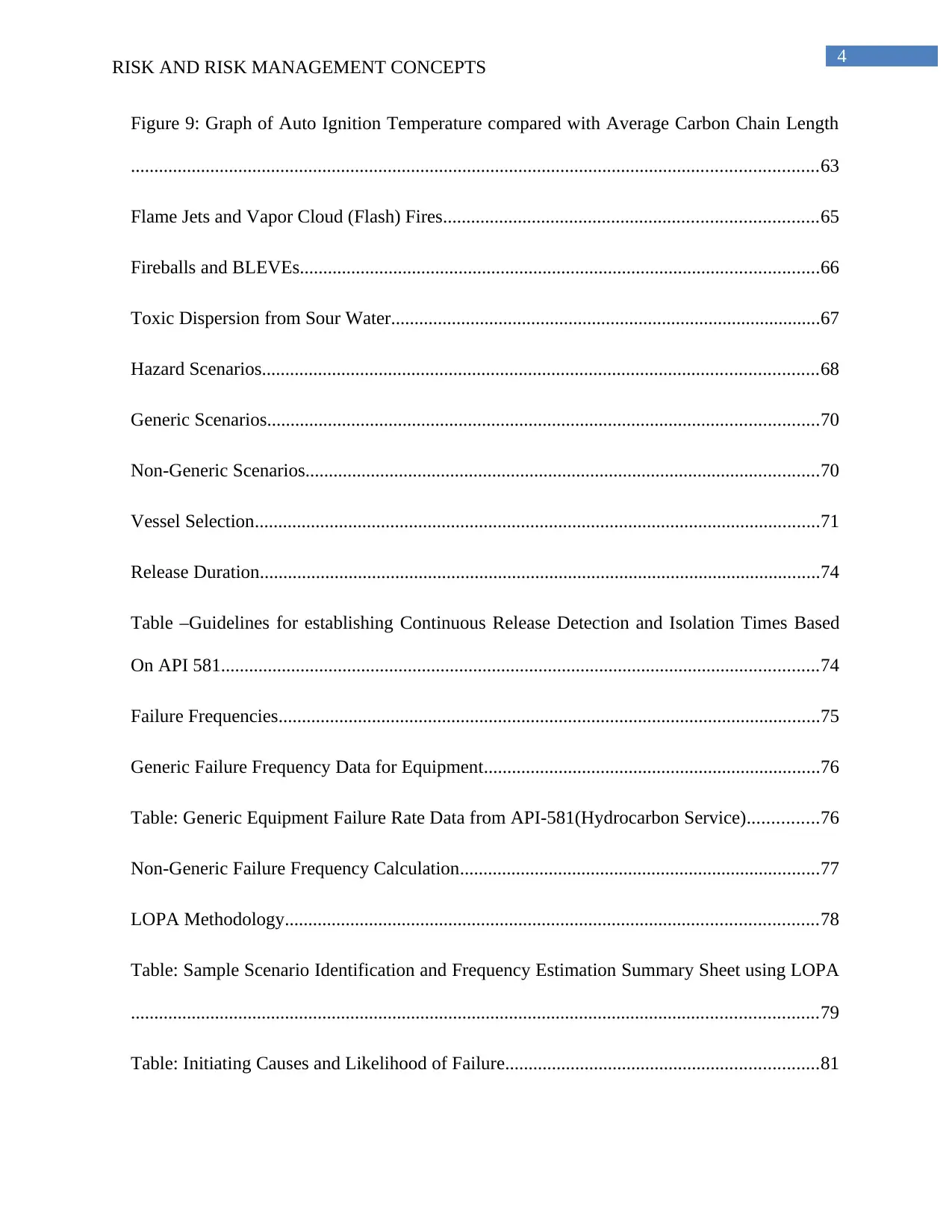
4
RISK AND RISK MANAGEMENT CONCEPTS
Figure 9: Graph of Auto Ignition Temperature compared with Average Carbon Chain Length
...................................................................................................................................................63
Flame Jets and Vapor Cloud (Flash) Fires................................................................................65
Fireballs and BLEVEs...............................................................................................................66
Toxic Dispersion from Sour Water............................................................................................67
Hazard Scenarios.......................................................................................................................68
Generic Scenarios......................................................................................................................70
Non-Generic Scenarios..............................................................................................................70
Vessel Selection.........................................................................................................................71
Release Duration........................................................................................................................74
Table –Guidelines for establishing Continuous Release Detection and Isolation Times Based
On API 581................................................................................................................................74
Failure Frequencies....................................................................................................................75
Generic Failure Frequency Data for Equipment........................................................................76
Table: Generic Equipment Failure Rate Data from API-581(Hydrocarbon Service)...............76
Non-Generic Failure Frequency Calculation.............................................................................77
LOPA Methodology..................................................................................................................78
Table: Sample Scenario Identification and Frequency Estimation Summary Sheet using LOPA
...................................................................................................................................................79
Table: Initiating Causes and Likelihood of Failure...................................................................81
RISK AND RISK MANAGEMENT CONCEPTS
Figure 9: Graph of Auto Ignition Temperature compared with Average Carbon Chain Length
...................................................................................................................................................63
Flame Jets and Vapor Cloud (Flash) Fires................................................................................65
Fireballs and BLEVEs...............................................................................................................66
Toxic Dispersion from Sour Water............................................................................................67
Hazard Scenarios.......................................................................................................................68
Generic Scenarios......................................................................................................................70
Non-Generic Scenarios..............................................................................................................70
Vessel Selection.........................................................................................................................71
Release Duration........................................................................................................................74
Table –Guidelines for establishing Continuous Release Detection and Isolation Times Based
On API 581................................................................................................................................74
Failure Frequencies....................................................................................................................75
Generic Failure Frequency Data for Equipment........................................................................76
Table: Generic Equipment Failure Rate Data from API-581(Hydrocarbon Service)...............76
Non-Generic Failure Frequency Calculation.............................................................................77
LOPA Methodology..................................................................................................................78
Table: Sample Scenario Identification and Frequency Estimation Summary Sheet using LOPA
...................................................................................................................................................79
Table: Initiating Causes and Likelihood of Failure...................................................................81
Paraphrase This Document
Need a fresh take? Get an instant paraphrase of this document with our AI Paraphraser
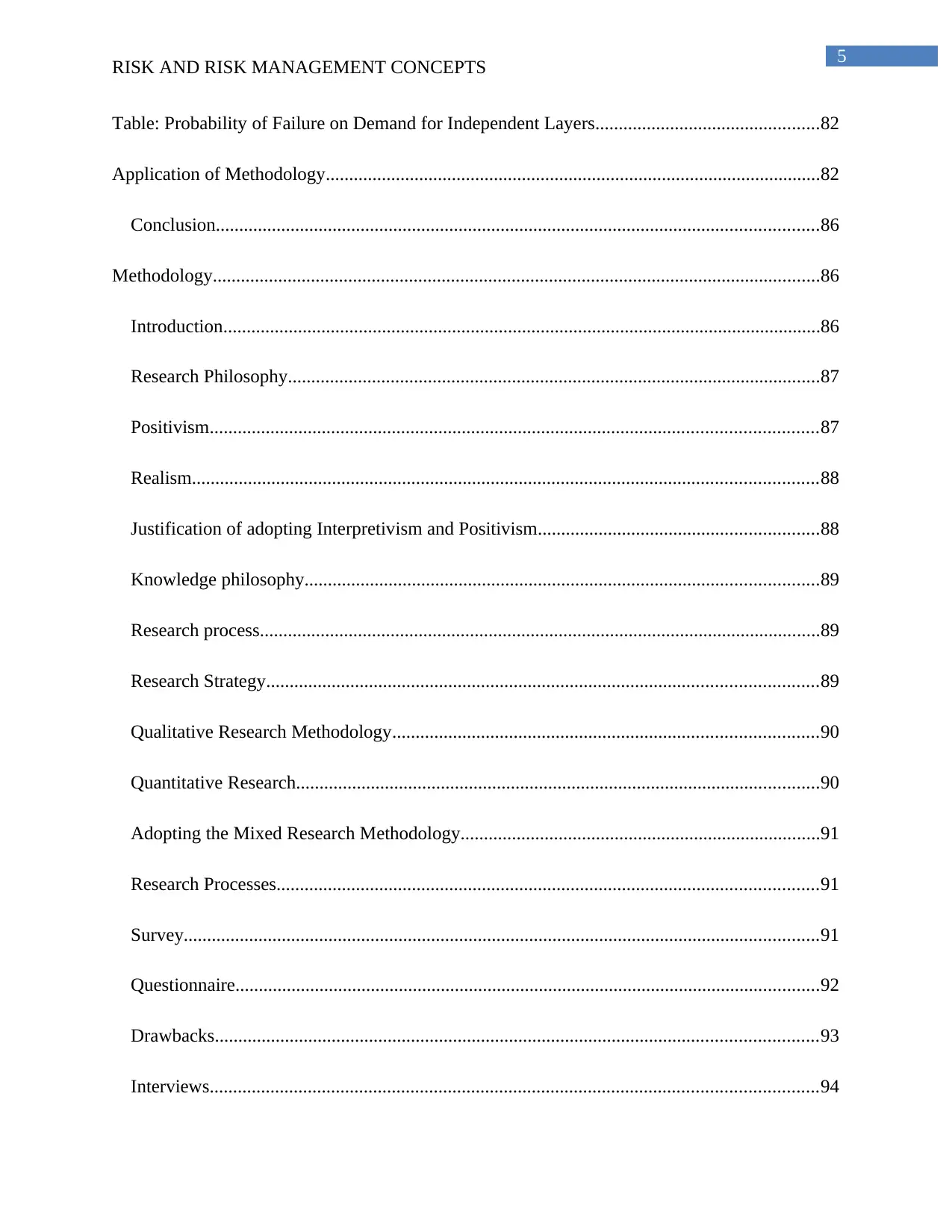
5
RISK AND RISK MANAGEMENT CONCEPTS
Table: Probability of Failure on Demand for Independent Layers................................................82
Application of Methodology..........................................................................................................82
Conclusion.................................................................................................................................86
Methodology..................................................................................................................................86
Introduction................................................................................................................................86
Research Philosophy..................................................................................................................87
Positivism..................................................................................................................................87
Realism......................................................................................................................................88
Justification of adopting Interpretivism and Positivism............................................................88
Knowledge philosophy..............................................................................................................89
Research process........................................................................................................................89
Research Strategy......................................................................................................................89
Qualitative Research Methodology...........................................................................................90
Quantitative Research................................................................................................................90
Adopting the Mixed Research Methodology.............................................................................91
Research Processes....................................................................................................................91
Survey........................................................................................................................................91
Questionnaire.............................................................................................................................92
Drawbacks.................................................................................................................................93
Interviews..................................................................................................................................94
RISK AND RISK MANAGEMENT CONCEPTS
Table: Probability of Failure on Demand for Independent Layers................................................82
Application of Methodology..........................................................................................................82
Conclusion.................................................................................................................................86
Methodology..................................................................................................................................86
Introduction................................................................................................................................86
Research Philosophy..................................................................................................................87
Positivism..................................................................................................................................87
Realism......................................................................................................................................88
Justification of adopting Interpretivism and Positivism............................................................88
Knowledge philosophy..............................................................................................................89
Research process........................................................................................................................89
Research Strategy......................................................................................................................89
Qualitative Research Methodology...........................................................................................90
Quantitative Research................................................................................................................90
Adopting the Mixed Research Methodology.............................................................................91
Research Processes....................................................................................................................91
Survey........................................................................................................................................91
Questionnaire.............................................................................................................................92
Drawbacks.................................................................................................................................93
Interviews..................................................................................................................................94
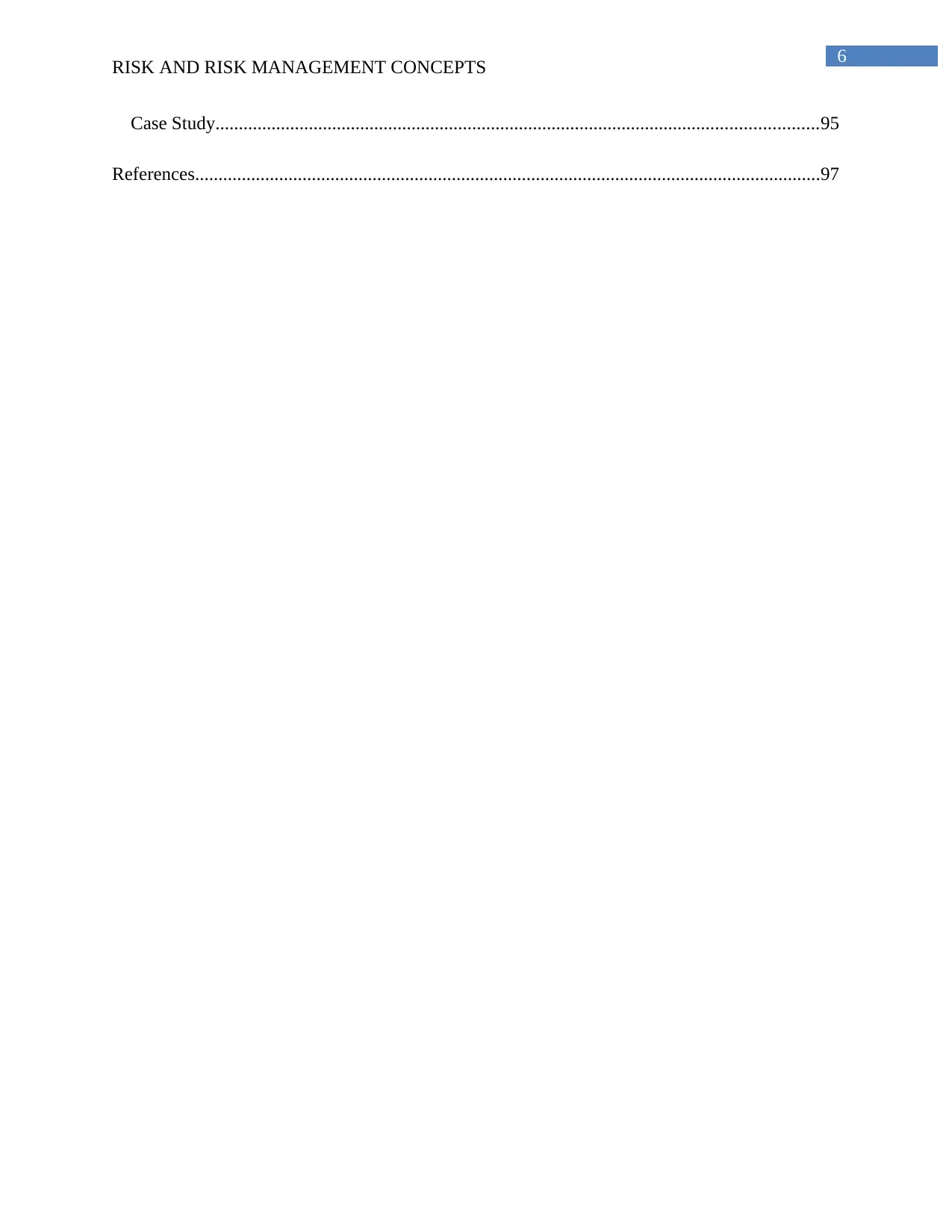
6
RISK AND RISK MANAGEMENT CONCEPTS
Case Study.................................................................................................................................95
References......................................................................................................................................97
RISK AND RISK MANAGEMENT CONCEPTS
Case Study.................................................................................................................................95
References......................................................................................................................................97
⊘ This is a preview!⊘
Do you want full access?
Subscribe today to unlock all pages.

Trusted by 1+ million students worldwide
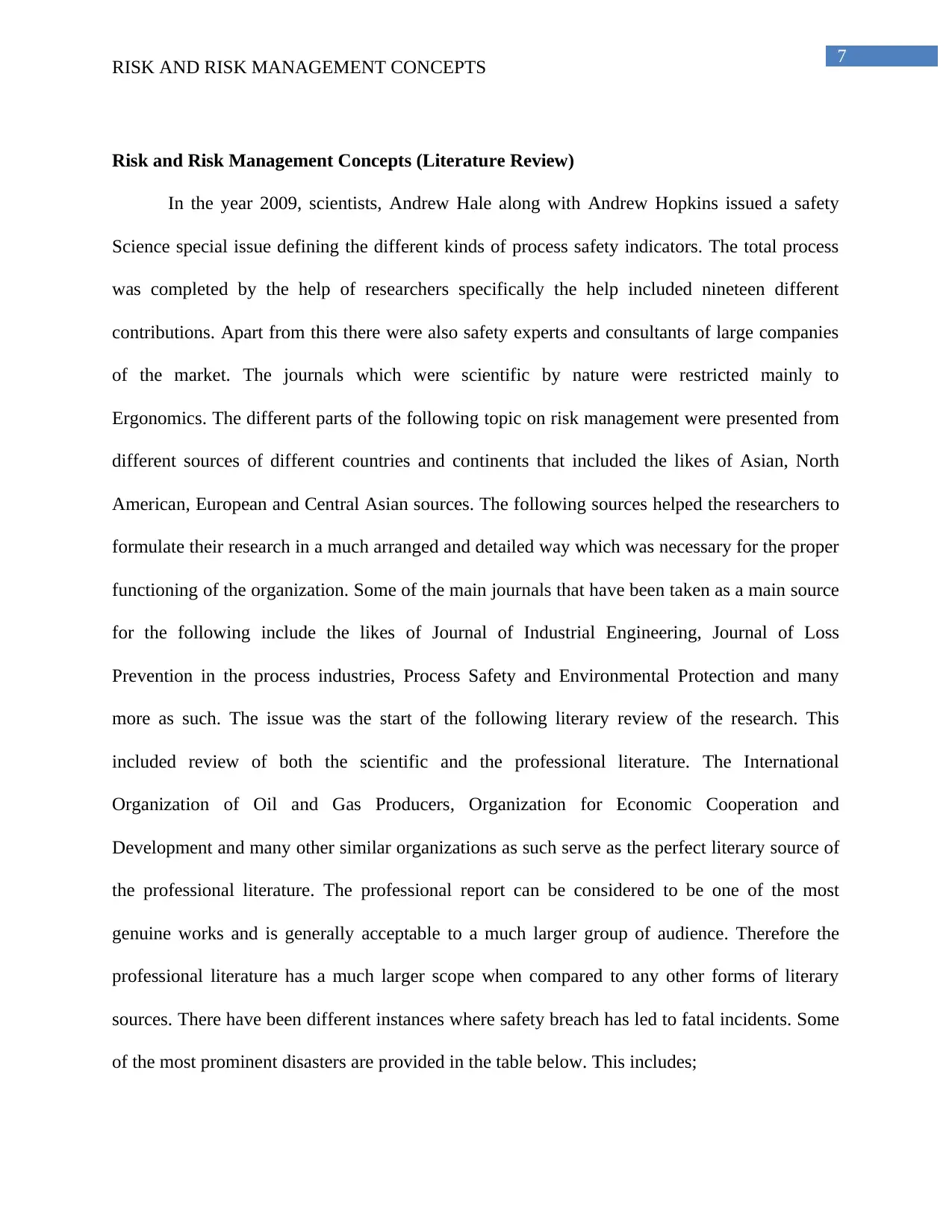
7
RISK AND RISK MANAGEMENT CONCEPTS
Risk and Risk Management Concepts (Literature Review)
In the year 2009, scientists, Andrew Hale along with Andrew Hopkins issued a safety
Science special issue defining the different kinds of process safety indicators. The total process
was completed by the help of researchers specifically the help included nineteen different
contributions. Apart from this there were also safety experts and consultants of large companies
of the market. The journals which were scientific by nature were restricted mainly to
Ergonomics. The different parts of the following topic on risk management were presented from
different sources of different countries and continents that included the likes of Asian, North
American, European and Central Asian sources. The following sources helped the researchers to
formulate their research in a much arranged and detailed way which was necessary for the proper
functioning of the organization. Some of the main journals that have been taken as a main source
for the following include the likes of Journal of Industrial Engineering, Journal of Loss
Prevention in the process industries, Process Safety and Environmental Protection and many
more as such. The issue was the start of the following literary review of the research. This
included review of both the scientific and the professional literature. The International
Organization of Oil and Gas Producers, Organization for Economic Cooperation and
Development and many other similar organizations as such serve as the perfect literary source of
the professional literature. The professional report can be considered to be one of the most
genuine works and is generally acceptable to a much larger group of audience. Therefore the
professional literature has a much larger scope when compared to any other forms of literary
sources. There have been different instances where safety breach has led to fatal incidents. Some
of the most prominent disasters are provided in the table below. This includes;
RISK AND RISK MANAGEMENT CONCEPTS
Risk and Risk Management Concepts (Literature Review)
In the year 2009, scientists, Andrew Hale along with Andrew Hopkins issued a safety
Science special issue defining the different kinds of process safety indicators. The total process
was completed by the help of researchers specifically the help included nineteen different
contributions. Apart from this there were also safety experts and consultants of large companies
of the market. The journals which were scientific by nature were restricted mainly to
Ergonomics. The different parts of the following topic on risk management were presented from
different sources of different countries and continents that included the likes of Asian, North
American, European and Central Asian sources. The following sources helped the researchers to
formulate their research in a much arranged and detailed way which was necessary for the proper
functioning of the organization. Some of the main journals that have been taken as a main source
for the following include the likes of Journal of Industrial Engineering, Journal of Loss
Prevention in the process industries, Process Safety and Environmental Protection and many
more as such. The issue was the start of the following literary review of the research. This
included review of both the scientific and the professional literature. The International
Organization of Oil and Gas Producers, Organization for Economic Cooperation and
Development and many other similar organizations as such serve as the perfect literary source of
the professional literature. The professional report can be considered to be one of the most
genuine works and is generally acceptable to a much larger group of audience. Therefore the
professional literature has a much larger scope when compared to any other forms of literary
sources. There have been different instances where safety breach has led to fatal incidents. Some
of the most prominent disasters are provided in the table below. This includes;
Paraphrase This Document
Need a fresh take? Get an instant paraphrase of this document with our AI Paraphraser
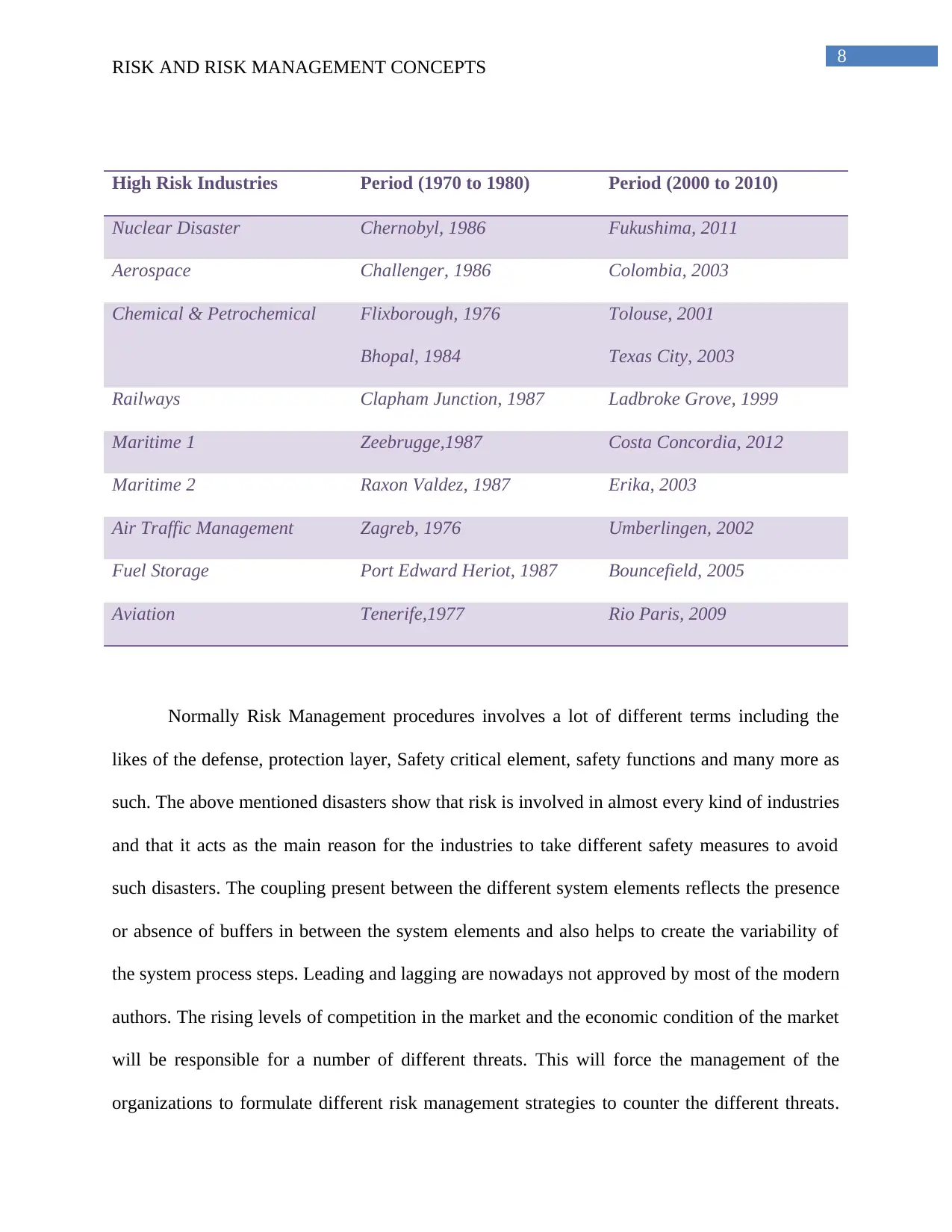
8
RISK AND RISK MANAGEMENT CONCEPTS
High Risk Industries Period (1970 to 1980) Period (2000 to 2010)
Nuclear Disaster Chernobyl, 1986 Fukushima, 2011
Aerospace Challenger, 1986 Colombia, 2003
Chemical & Petrochemical Flixborough, 1976
Bhopal, 1984
Tolouse, 2001
Texas City, 2003
Railways Clapham Junction, 1987 Ladbroke Grove, 1999
Maritime 1 Zeebrugge,1987 Costa Concordia, 2012
Maritime 2 Raxon Valdez, 1987 Erika, 2003
Air Traffic Management Zagreb, 1976 Umberlingen, 2002
Fuel Storage Port Edward Heriot, 1987 Bouncefield, 2005
Aviation Tenerife,1977 Rio Paris, 2009
Normally Risk Management procedures involves a lot of different terms including the
likes of the defense, protection layer, Safety critical element, safety functions and many more as
such. The above mentioned disasters show that risk is involved in almost every kind of industries
and that it acts as the main reason for the industries to take different safety measures to avoid
such disasters. The coupling present between the different system elements reflects the presence
or absence of buffers in between the system elements and also helps to create the variability of
the system process steps. Leading and lagging are nowadays not approved by most of the modern
authors. The rising levels of competition in the market and the economic condition of the market
will be responsible for a number of different threats. This will force the management of the
organizations to formulate different risk management strategies to counter the different threats.
RISK AND RISK MANAGEMENT CONCEPTS
High Risk Industries Period (1970 to 1980) Period (2000 to 2010)
Nuclear Disaster Chernobyl, 1986 Fukushima, 2011
Aerospace Challenger, 1986 Colombia, 2003
Chemical & Petrochemical Flixborough, 1976
Bhopal, 1984
Tolouse, 2001
Texas City, 2003
Railways Clapham Junction, 1987 Ladbroke Grove, 1999
Maritime 1 Zeebrugge,1987 Costa Concordia, 2012
Maritime 2 Raxon Valdez, 1987 Erika, 2003
Air Traffic Management Zagreb, 1976 Umberlingen, 2002
Fuel Storage Port Edward Heriot, 1987 Bouncefield, 2005
Aviation Tenerife,1977 Rio Paris, 2009
Normally Risk Management procedures involves a lot of different terms including the
likes of the defense, protection layer, Safety critical element, safety functions and many more as
such. The above mentioned disasters show that risk is involved in almost every kind of industries
and that it acts as the main reason for the industries to take different safety measures to avoid
such disasters. The coupling present between the different system elements reflects the presence
or absence of buffers in between the system elements and also helps to create the variability of
the system process steps. Leading and lagging are nowadays not approved by most of the modern
authors. The rising levels of competition in the market and the economic condition of the market
will be responsible for a number of different threats. This will force the management of the
organizations to formulate different risk management strategies to counter the different threats.
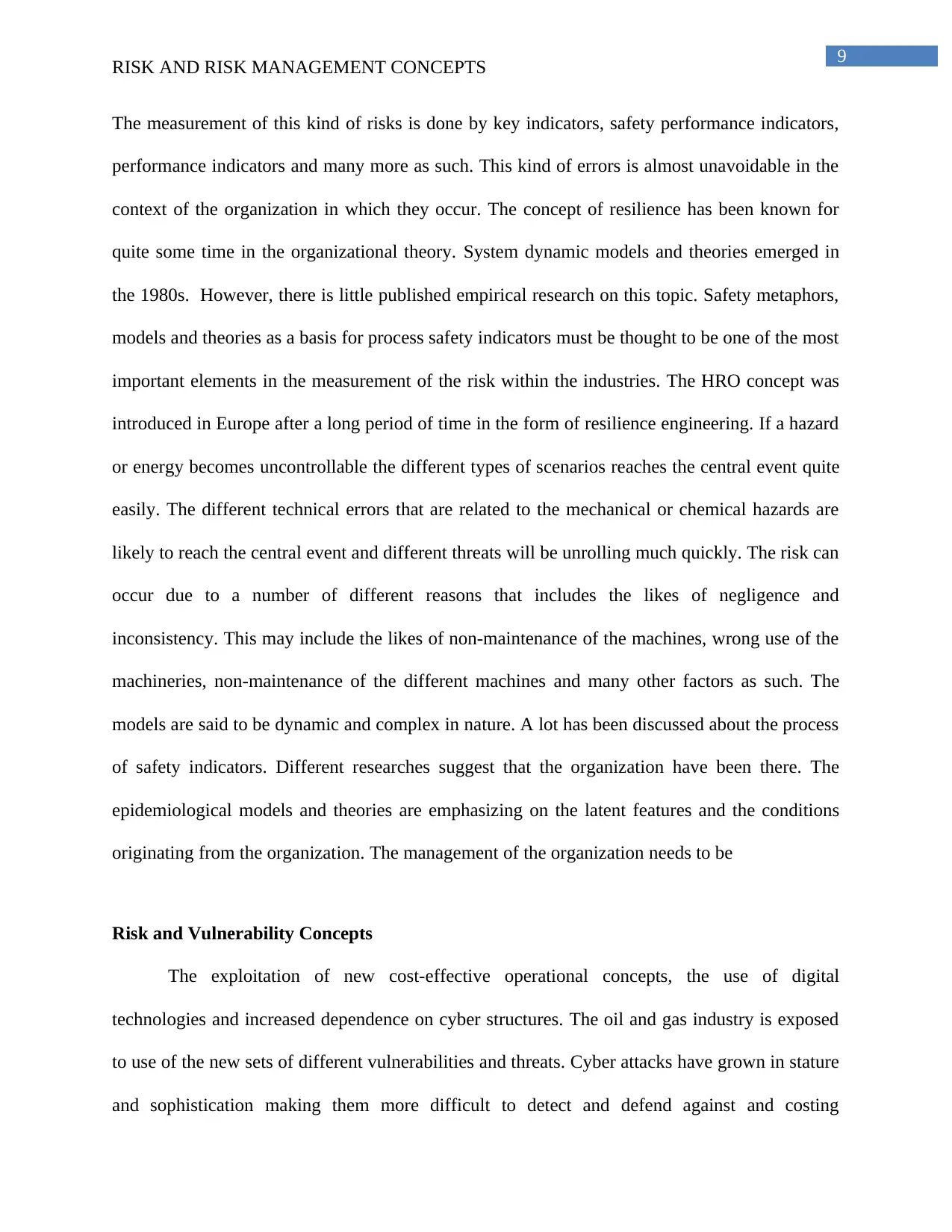
9
RISK AND RISK MANAGEMENT CONCEPTS
The measurement of this kind of risks is done by key indicators, safety performance indicators,
performance indicators and many more as such. This kind of errors is almost unavoidable in the
context of the organization in which they occur. The concept of resilience has been known for
quite some time in the organizational theory. System dynamic models and theories emerged in
the 1980s. However, there is little published empirical research on this topic. Safety metaphors,
models and theories as a basis for process safety indicators must be thought to be one of the most
important elements in the measurement of the risk within the industries. The HRO concept was
introduced in Europe after a long period of time in the form of resilience engineering. If a hazard
or energy becomes uncontrollable the different types of scenarios reaches the central event quite
easily. The different technical errors that are related to the mechanical or chemical hazards are
likely to reach the central event and different threats will be unrolling much quickly. The risk can
occur due to a number of different reasons that includes the likes of negligence and
inconsistency. This may include the likes of non-maintenance of the machines, wrong use of the
machineries, non-maintenance of the different machines and many other factors as such. The
models are said to be dynamic and complex in nature. A lot has been discussed about the process
of safety indicators. Different researches suggest that the organization have been there. The
epidemiological models and theories are emphasizing on the latent features and the conditions
originating from the organization. The management of the organization needs to be
Risk and Vulnerability Concepts
The exploitation of new cost-effective operational concepts, the use of digital
technologies and increased dependence on cyber structures. The oil and gas industry is exposed
to use of the new sets of different vulnerabilities and threats. Cyber attacks have grown in stature
and sophistication making them more difficult to detect and defend against and costing
RISK AND RISK MANAGEMENT CONCEPTS
The measurement of this kind of risks is done by key indicators, safety performance indicators,
performance indicators and many more as such. This kind of errors is almost unavoidable in the
context of the organization in which they occur. The concept of resilience has been known for
quite some time in the organizational theory. System dynamic models and theories emerged in
the 1980s. However, there is little published empirical research on this topic. Safety metaphors,
models and theories as a basis for process safety indicators must be thought to be one of the most
important elements in the measurement of the risk within the industries. The HRO concept was
introduced in Europe after a long period of time in the form of resilience engineering. If a hazard
or energy becomes uncontrollable the different types of scenarios reaches the central event quite
easily. The different technical errors that are related to the mechanical or chemical hazards are
likely to reach the central event and different threats will be unrolling much quickly. The risk can
occur due to a number of different reasons that includes the likes of negligence and
inconsistency. This may include the likes of non-maintenance of the machines, wrong use of the
machineries, non-maintenance of the different machines and many other factors as such. The
models are said to be dynamic and complex in nature. A lot has been discussed about the process
of safety indicators. Different researches suggest that the organization have been there. The
epidemiological models and theories are emphasizing on the latent features and the conditions
originating from the organization. The management of the organization needs to be
Risk and Vulnerability Concepts
The exploitation of new cost-effective operational concepts, the use of digital
technologies and increased dependence on cyber structures. The oil and gas industry is exposed
to use of the new sets of different vulnerabilities and threats. Cyber attacks have grown in stature
and sophistication making them more difficult to detect and defend against and costing
⊘ This is a preview!⊘
Do you want full access?
Subscribe today to unlock all pages.

Trusted by 1+ million students worldwide
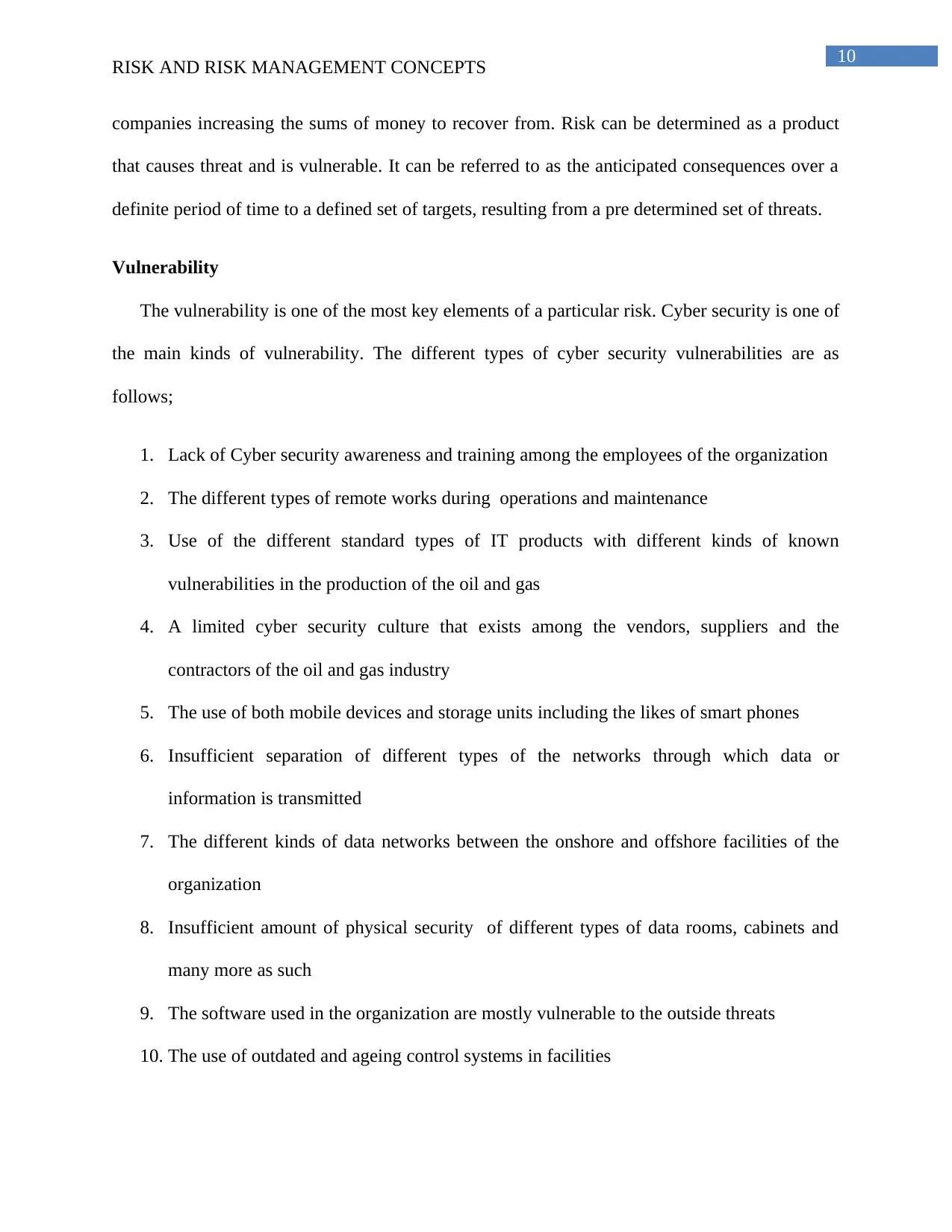
10
RISK AND RISK MANAGEMENT CONCEPTS
companies increasing the sums of money to recover from. Risk can be determined as a product
that causes threat and is vulnerable. It can be referred to as the anticipated consequences over a
definite period of time to a defined set of targets, resulting from a pre determined set of threats.
Vulnerability
The vulnerability is one of the most key elements of a particular risk. Cyber security is one of
the main kinds of vulnerability. The different types of cyber security vulnerabilities are as
follows;
1. Lack of Cyber security awareness and training among the employees of the organization
2. The different types of remote works during operations and maintenance
3. Use of the different standard types of IT products with different kinds of known
vulnerabilities in the production of the oil and gas
4. A limited cyber security culture that exists among the vendors, suppliers and the
contractors of the oil and gas industry
5. The use of both mobile devices and storage units including the likes of smart phones
6. Insufficient separation of different types of the networks through which data or
information is transmitted
7. The different kinds of data networks between the onshore and offshore facilities of the
organization
8. Insufficient amount of physical security of different types of data rooms, cabinets and
many more as such
9. The software used in the organization are mostly vulnerable to the outside threats
10. The use of outdated and ageing control systems in facilities
RISK AND RISK MANAGEMENT CONCEPTS
companies increasing the sums of money to recover from. Risk can be determined as a product
that causes threat and is vulnerable. It can be referred to as the anticipated consequences over a
definite period of time to a defined set of targets, resulting from a pre determined set of threats.
Vulnerability
The vulnerability is one of the most key elements of a particular risk. Cyber security is one of
the main kinds of vulnerability. The different types of cyber security vulnerabilities are as
follows;
1. Lack of Cyber security awareness and training among the employees of the organization
2. The different types of remote works during operations and maintenance
3. Use of the different standard types of IT products with different kinds of known
vulnerabilities in the production of the oil and gas
4. A limited cyber security culture that exists among the vendors, suppliers and the
contractors of the oil and gas industry
5. The use of both mobile devices and storage units including the likes of smart phones
6. Insufficient separation of different types of the networks through which data or
information is transmitted
7. The different kinds of data networks between the onshore and offshore facilities of the
organization
8. Insufficient amount of physical security of different types of data rooms, cabinets and
many more as such
9. The software used in the organization are mostly vulnerable to the outside threats
10. The use of outdated and ageing control systems in facilities
Paraphrase This Document
Need a fresh take? Get an instant paraphrase of this document with our AI Paraphraser
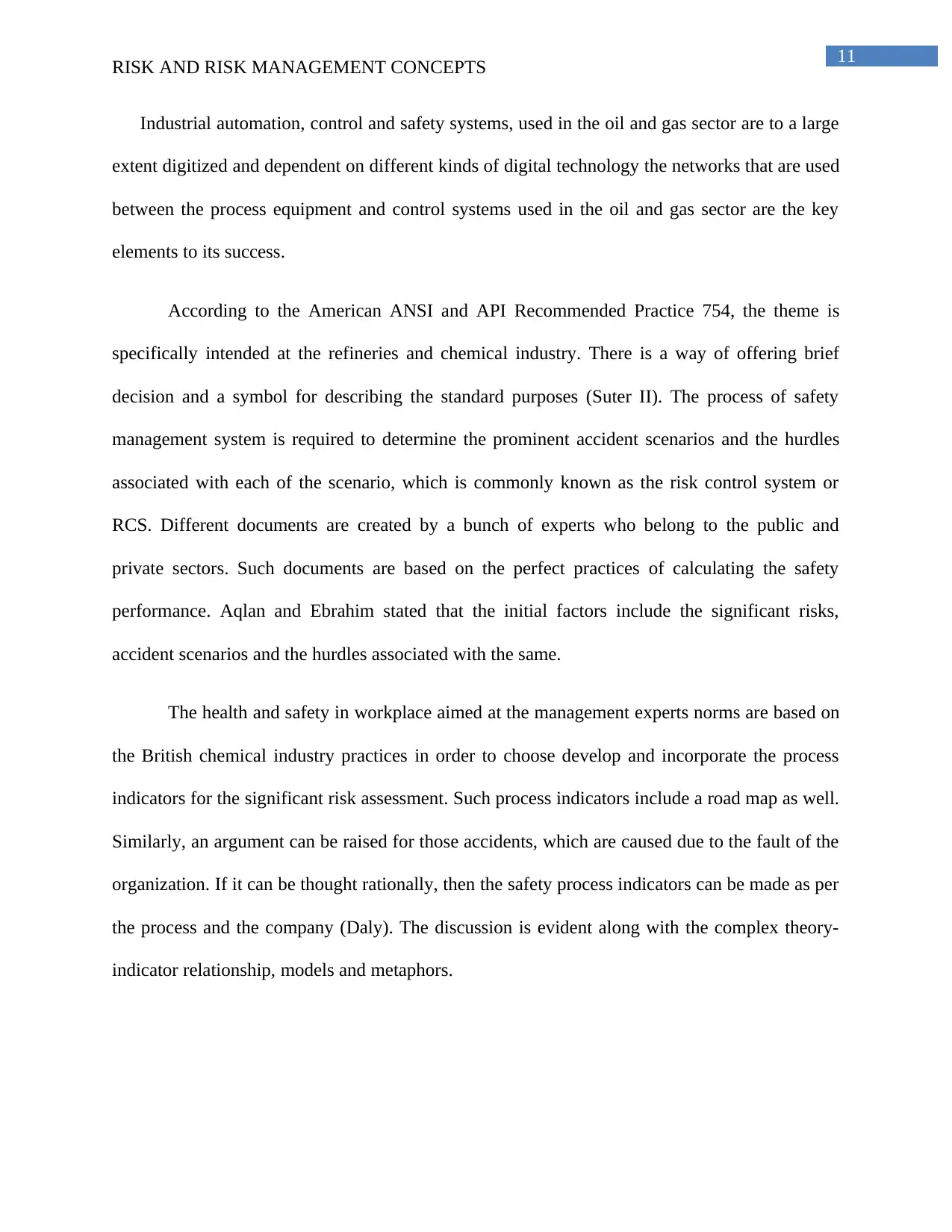
11
RISK AND RISK MANAGEMENT CONCEPTS
Industrial automation, control and safety systems, used in the oil and gas sector are to a large
extent digitized and dependent on different kinds of digital technology the networks that are used
between the process equipment and control systems used in the oil and gas sector are the key
elements to its success.
According to the American ANSI and API Recommended Practice 754, the theme is
specifically intended at the refineries and chemical industry. There is a way of offering brief
decision and a symbol for describing the standard purposes (Suter II). The process of safety
management system is required to determine the prominent accident scenarios and the hurdles
associated with each of the scenario, which is commonly known as the risk control system or
RCS. Different documents are created by a bunch of experts who belong to the public and
private sectors. Such documents are based on the perfect practices of calculating the safety
performance. Aqlan and Ebrahim stated that the initial factors include the significant risks,
accident scenarios and the hurdles associated with the same.
The health and safety in workplace aimed at the management experts norms are based on
the British chemical industry practices in order to choose develop and incorporate the process
indicators for the significant risk assessment. Such process indicators include a road map as well.
Similarly, an argument can be raised for those accidents, which are caused due to the fault of the
organization. If it can be thought rationally, then the safety process indicators can be made as per
the process and the company (Daly). The discussion is evident along with the complex theory-
indicator relationship, models and metaphors.
RISK AND RISK MANAGEMENT CONCEPTS
Industrial automation, control and safety systems, used in the oil and gas sector are to a large
extent digitized and dependent on different kinds of digital technology the networks that are used
between the process equipment and control systems used in the oil and gas sector are the key
elements to its success.
According to the American ANSI and API Recommended Practice 754, the theme is
specifically intended at the refineries and chemical industry. There is a way of offering brief
decision and a symbol for describing the standard purposes (Suter II). The process of safety
management system is required to determine the prominent accident scenarios and the hurdles
associated with each of the scenario, which is commonly known as the risk control system or
RCS. Different documents are created by a bunch of experts who belong to the public and
private sectors. Such documents are based on the perfect practices of calculating the safety
performance. Aqlan and Ebrahim stated that the initial factors include the significant risks,
accident scenarios and the hurdles associated with the same.
The health and safety in workplace aimed at the management experts norms are based on
the British chemical industry practices in order to choose develop and incorporate the process
indicators for the significant risk assessment. Such process indicators include a road map as well.
Similarly, an argument can be raised for those accidents, which are caused due to the fault of the
organization. If it can be thought rationally, then the safety process indicators can be made as per
the process and the company (Daly). The discussion is evident along with the complex theory-
indicator relationship, models and metaphors.
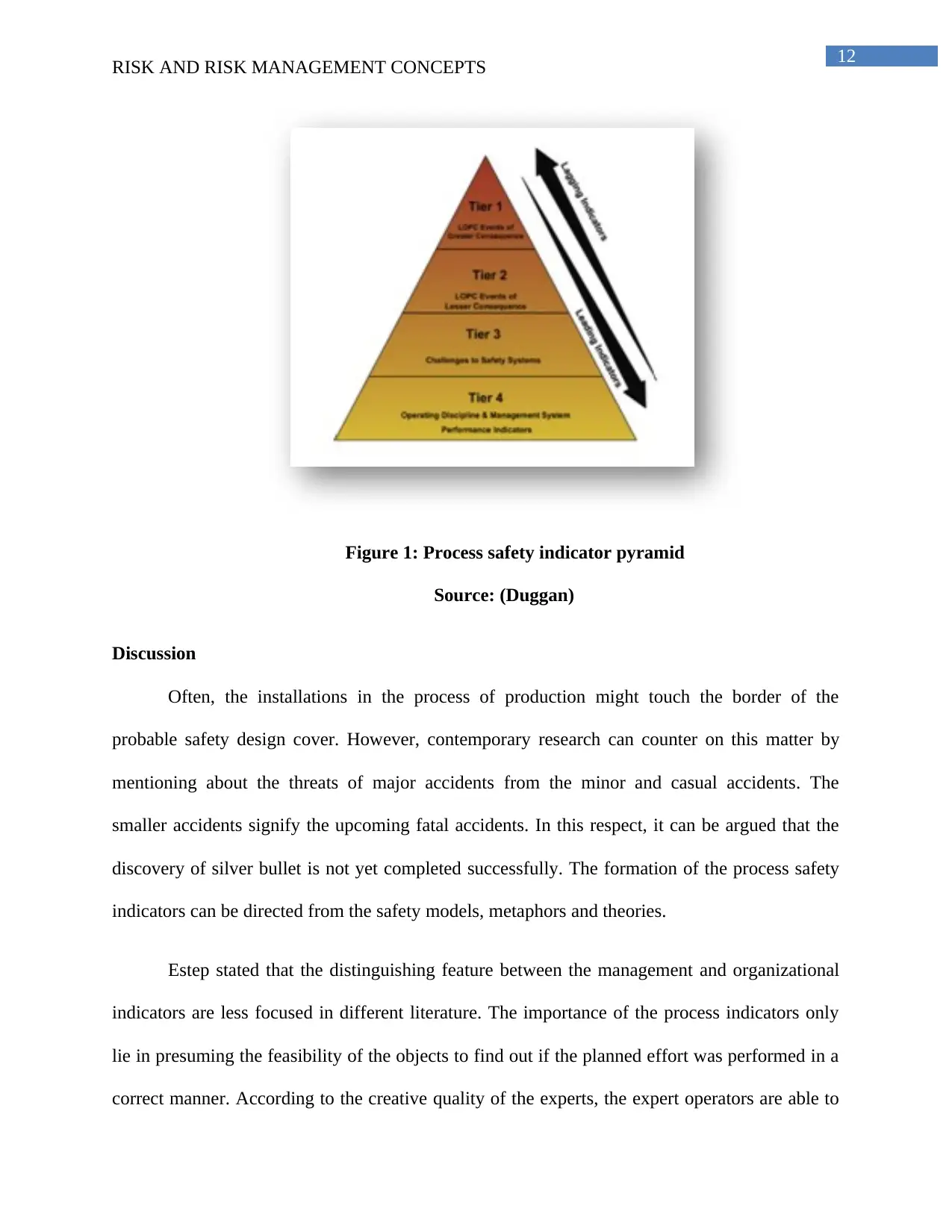
12
RISK AND RISK MANAGEMENT CONCEPTS
Figure 1: Process safety indicator pyramid
Source: (Duggan)
Discussion
Often, the installations in the process of production might touch the border of the
probable safety design cover. However, contemporary research can counter on this matter by
mentioning about the threats of major accidents from the minor and casual accidents. The
smaller accidents signify the upcoming fatal accidents. In this respect, it can be argued that the
discovery of silver bullet is not yet completed successfully. The formation of the process safety
indicators can be directed from the safety models, metaphors and theories.
Estep stated that the distinguishing feature between the management and organizational
indicators are less focused in different literature. The importance of the process indicators only
lie in presuming the feasibility of the objects to find out if the planned effort was performed in a
correct manner. According to the creative quality of the experts, the expert operators are able to
RISK AND RISK MANAGEMENT CONCEPTS
Figure 1: Process safety indicator pyramid
Source: (Duggan)
Discussion
Often, the installations in the process of production might touch the border of the
probable safety design cover. However, contemporary research can counter on this matter by
mentioning about the threats of major accidents from the minor and casual accidents. The
smaller accidents signify the upcoming fatal accidents. In this respect, it can be argued that the
discovery of silver bullet is not yet completed successfully. The formation of the process safety
indicators can be directed from the safety models, metaphors and theories.
Estep stated that the distinguishing feature between the management and organizational
indicators are less focused in different literature. The importance of the process indicators only
lie in presuming the feasibility of the objects to find out if the planned effort was performed in a
correct manner. According to the creative quality of the experts, the expert operators are able to
⊘ This is a preview!⊘
Do you want full access?
Subscribe today to unlock all pages.

Trusted by 1+ million students worldwide
1 out of 105
Your All-in-One AI-Powered Toolkit for Academic Success.
+13062052269
info@desklib.com
Available 24*7 on WhatsApp / Email
![[object Object]](/_next/static/media/star-bottom.7253800d.svg)
Unlock your academic potential
Copyright © 2020–2025 A2Z Services. All Rights Reserved. Developed and managed by ZUCOL.